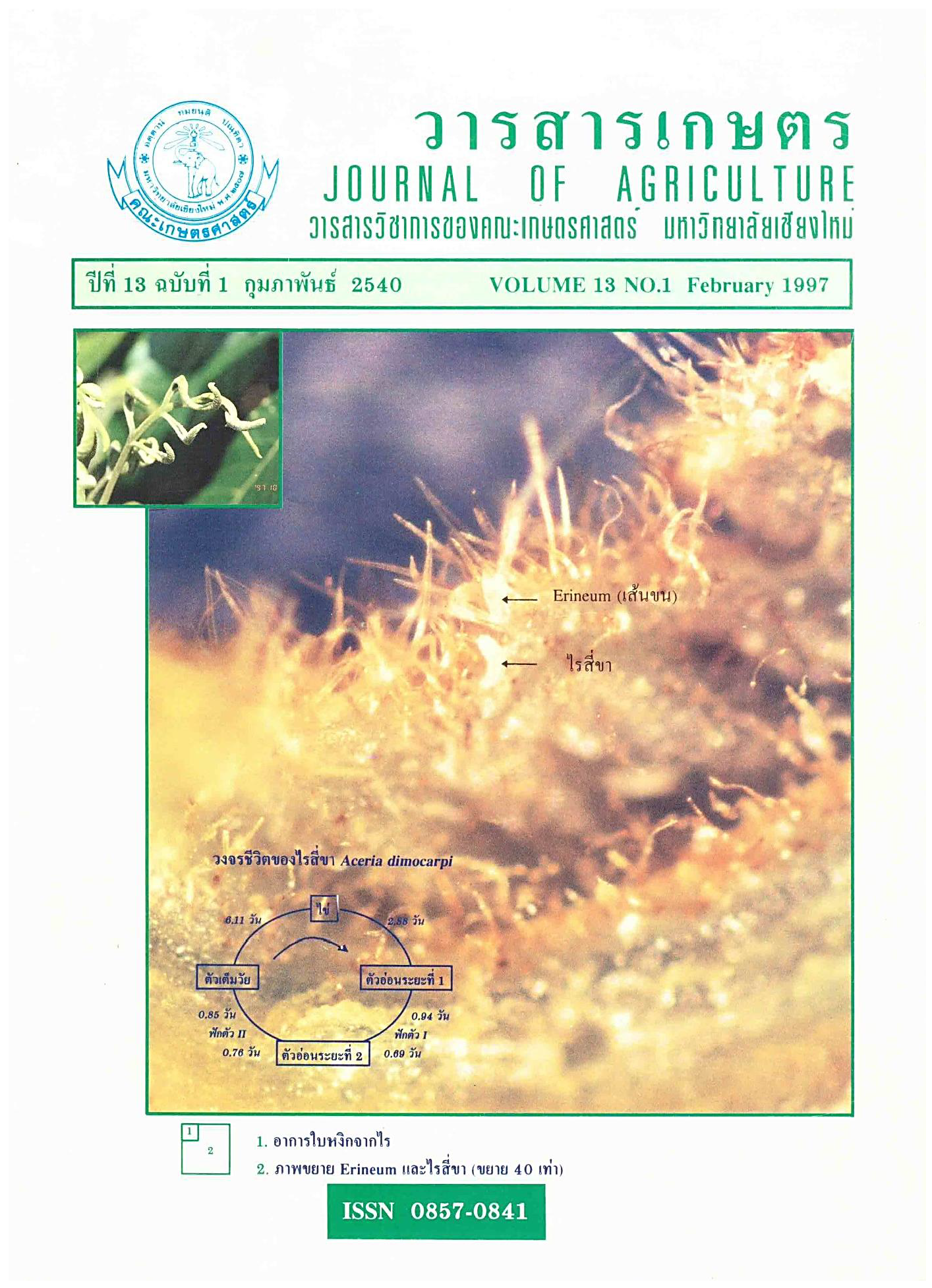การพัฒนาวัสดุเพาะและการเปรียบเทียบผลผลิตของเห็ดนางรมลูกผสม
Main Article Content
บทคัดย่อ
การศึกษาวัสดุเพาะที่เหมาะสมในการเพาะเห็ดลูกผสมสายพันธุ์ KDCM-4 พบว่าการผสมขี้เลื่อยไม้ยางพาราและไม้นุ่นอัตราส่วน 1:1, ปูนขาว 1%, แมกนีเซียมซัลเฟต 1.5%, รำละเอียด 20% และความชื้นในวัสดุเพาะ 74% ให้ผลผลิตสูงสุด เมื่อนำส่วนผสมข้างต้น (สูตรที่ 1) มาเปรียบเทียบกับวัสดุเพาะสูตรที่ 2 โดยมีอัตราส่วนขี้เลื่อยเดิม, ปูนขาว 1%, แมกนีเซียมซัลเฟต 0.2%, รำละเอียด 10% และความชื้นในวัสดุเพาะ 70% พบว่าวัสดุเพาะสูตรที่ 1 ให้ผลผลิตสูงสุด
การทดสอบผลผลิตเห็ดลูกผสม 5 สายพันธุ์เปรียบเทียบกับแม่พันธุ์นางรมจากญี่ปุ่น (KD1) และแม่พันธุ์นางรมฮังการีของภาควิชาพืชสวน มหาวิทยาลัยเชียงใหม่ (CM1) พบว่า CM1 ให้ผลผลิตสูงสุด รองลงมา ได้แก่ ลูกผสมสายพันธุ์ KDCM-4 เมื่อนำเห็ดทั้ง 7 สายพันธุ์มาวิเคราะห์หารูปแบบไอโซไซม์ Esterase, Peroxidase และ Acid phosphatase โดยใช้ Polyacrylamide gel 8.5% ผลปรากฏว่าไซโมแกรมของเส้นใยเห็ดลูกผสมมีความสัมพันธ์ที่ชัดเจนกับไซโมแกรมของเส้นใยพ่อแม่ โดยแถบสีส่วนใหญ่คล้ายกันกับแถบสีของแม่พันธุ์นางรมจากญี่ปุ่น
Article Details
เอกสารอ้างอิง
Deniel J.R. and M. Bernie. 1982. Use of isozyme variation to identify genotypic classes of Agaricus brunnescens. Mycology Res. 100(6) 717-731.
Gerrits, J.P.G. 1959. The influence of water in mushroom compost. Mushroom Sci. (4)
Kalberer, P. and U. Kunsch. 1974. Amino acid composition of the oyster mushroom (Pleurotus ostreatus). Lebensm-Wiss. U. Technol. 7: 242-244.
Molitoris, H.P. 1978. Wood degradation, phenoloxidase and chemotaxonomy of higher fungi. Mushroom Sci. X: 243-236.
Ranjhan, S., J.C. Glaszmann., D.A.Ramirez and G.S Khush. 1987. Chromosomal location of four
isozymes loci by trisomic analysis in rice (Oryza sativa L. ). Theor. Appl. Genet. 75: 541-545. Song C.H., K.Y. Cho. 1989, Growth stimulation and lipid synthesis in Lentinus edodes. Mycologia. 81 (4): 514-522.
Tan, K.K. 1981. Cultivation of the oyster mushroom Pleurotus ostreatus, on cotton waste. Mushroom Sci. 6: 697-703.
Visscher, H.R. 1987. Supplementation of the substrate for Pleurotus species at filling. Mushroom Sci. 7(Part 2): 229-240.
Zadrazil F. 1974. The ecology and industrial production of Pleurotus ostreatus, Pleurotus florida, Pleurotus comucopiae, and Pleurotus eryngiï. Mushroom Sci. 4 (Part 1): 621-652.
Zervakis, G. J. Sourdis and B. Constantinos. 1994. Genetic variability and systematics of eleven Pleurotus species based on isozyme analysis. Mycology Res. 98(3): 329-341.


